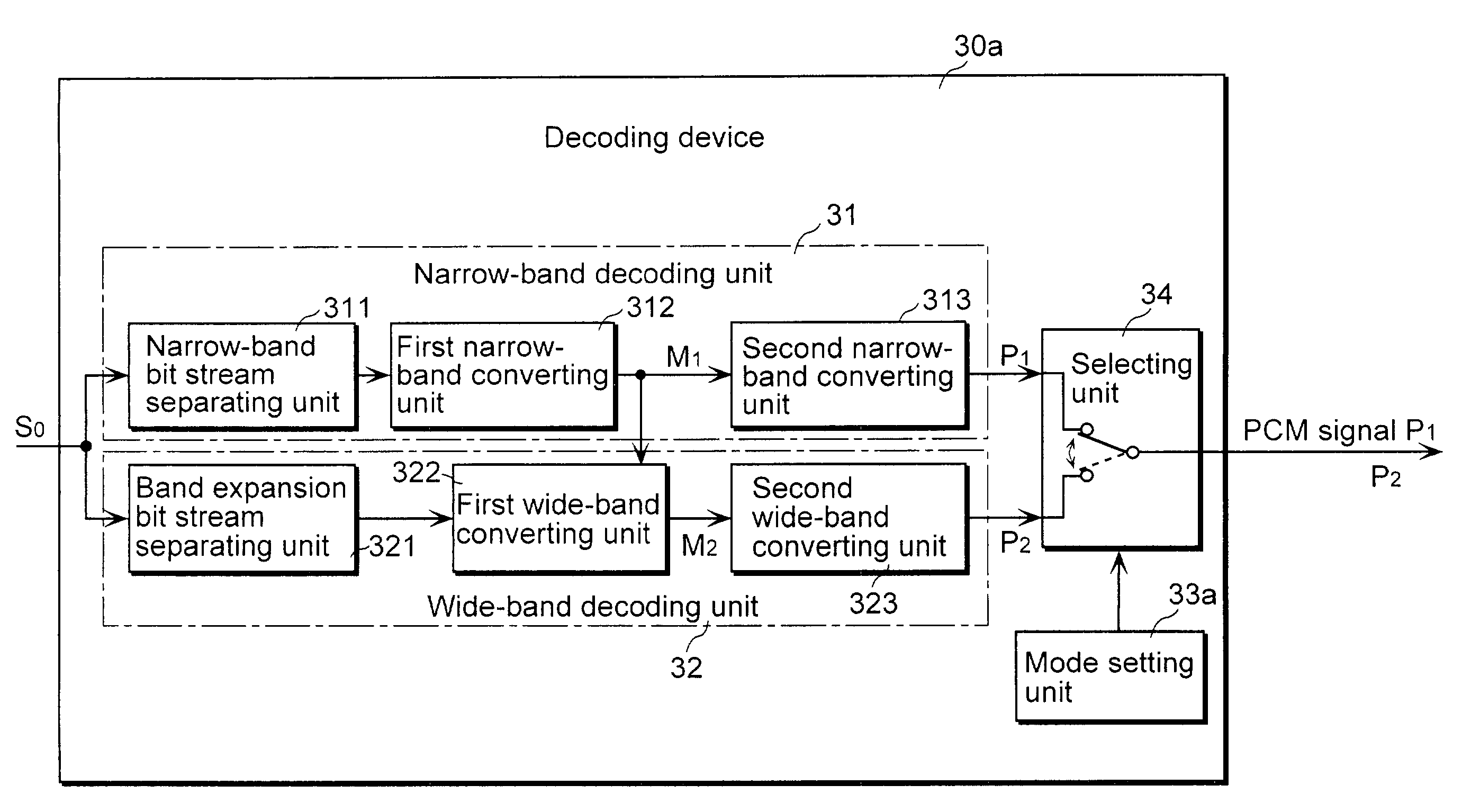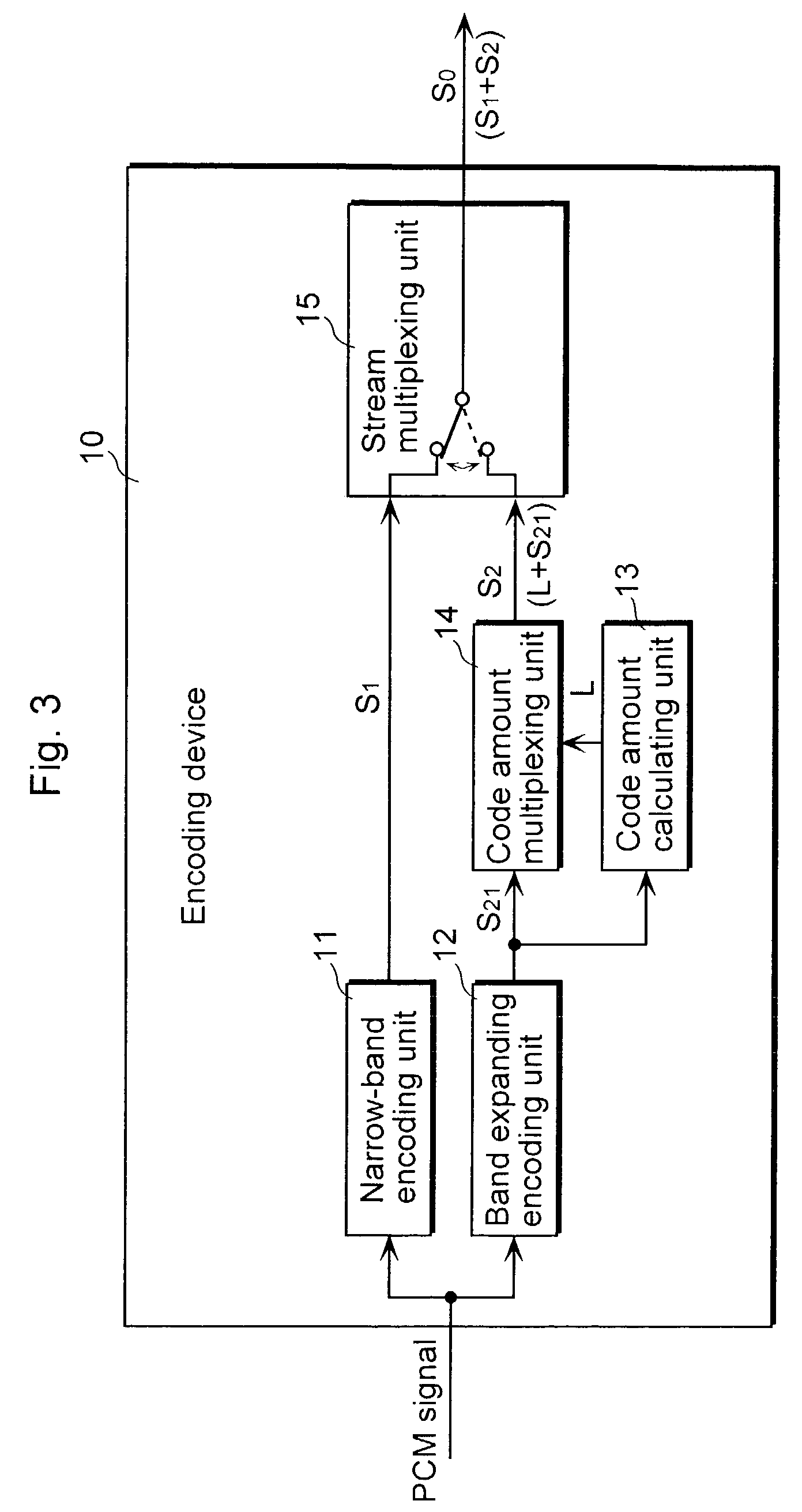Encoding device, decoding device, and system thereof utilizing band expansion information
a decoding device and band expansion technology, applied in the field of encoding and decoding processing of audio signals, can solve the problems of inability to reproduce high frequencies, inability to perform pseudo wide band processing, and inability to provide constant high-quality sounds. achieve the effect of reducing power consumption
- Summary
- Abstract
- Description
- Claims
- Application Information
AI Technical Summary
Benefits of technology
Problems solved by technology
Method used
Image
Examples
first embodiment
THE FIRST EMBODIMENT
[0049]First, an explanation is provided for a decoding device which facilitates the achievement of the first and the second objects in an encoding device.
[0050]An encoding device according to the First Embodiment of the present invention is explained in subsequent paragraphs with reference to the figures.
[0051]FIG. 3 is a block diagram illustrating a functional configuration of an encoding device 10 according to the First Embodiment.
[0052]The encoding device 10 is comprised of a narrow-band encoding unit 11, a band expanding encoding unit 12, a code amount calculating unit 13, a code amount multiplexing unit 14, and a stream multiplexing unit 15.
[0053]The narrow-band encoding unit 11 encodes an inputted PCM signal per frame (in AAC, 1024 samples in the audio data row) and generates a narrow-band bit stream S1 at low frequencies.
[0054]Based on the inputted PCM signal, the band expanding encoding unit 12 acquires band expansion information used for expanding the re...
second embodiment
THE SECOND EMBODIMENT
[0079]Next, an explanation is provided for a decoding device according to the Second Embodiment of the present invention with reference to the figures.
[0080]FIG. 8 is a block diagram showing a functional configuration of a decoding device 30a according to the Second Embodiment.
[0081]The decoding device 30a is comprised of a narrow-band decoding unit 31 which separates and decodes only the narrow-band bit stream S1 from the wide-band bit stream S0 outputted from the encoding device 10, a wide-band decoding unit 32 which separates and decodes only the band expansion bit stream S2, a selecting unit 34 which selects either a PCM signal in the narrow band (narrow-band PCM signal) decoded by the narrow-band decoding unit 31 or a PCM signal in the wide band (wide-band PCM signal) which is decoded by the wide-band decoding unit 32 and which expands to the narrow band by the amount of band expansion, and a mode setting unit 33a which sets a signal selection mode selected...
third embodiment
THE THIRD EMBODIMENT
[0103]Next, an explanation is provided for a decoding device 30b according to the Third Embodiment of the present invention.
[0104]FIG. 11 is a block diagram showing a functional configuration of a decoding device 30 according to the decoding device 30b of the present invention. Note that the same numbers as those used for the decoding device 30a in FIG. 8 are assigned to the corresponding parts in FIG. 11, in which detailed explanations are given only for the parts different from FIG. 8.
[0105]It should be noted that, in the decoding device 30a according to the Second Embodiment, the selecting unit 34 is responsible for the selection between a PCM signal P2 for which band expansion is performed and an output PCM signal P1 for which band expansion is not performed, but the decoding device 30b further includes a controlling unit 35 so as to reduce the processing amount at the time of outputting a PCM signal P1 for which band expansion is not performed.
[0106]The cont...
PUM
 Login to View More
Login to View More Abstract
Description
Claims
Application Information
 Login to View More
Login to View More - R&D
- Intellectual Property
- Life Sciences
- Materials
- Tech Scout
- Unparalleled Data Quality
- Higher Quality Content
- 60% Fewer Hallucinations
Browse by: Latest US Patents, China's latest patents, Technical Efficacy Thesaurus, Application Domain, Technology Topic, Popular Technical Reports.
© 2025 PatSnap. All rights reserved.Legal|Privacy policy|Modern Slavery Act Transparency Statement|Sitemap|About US| Contact US: help@patsnap.com



